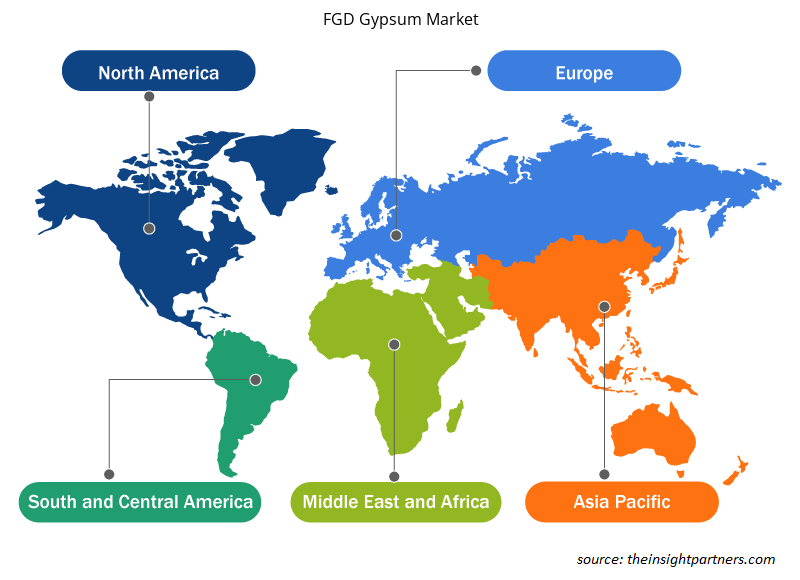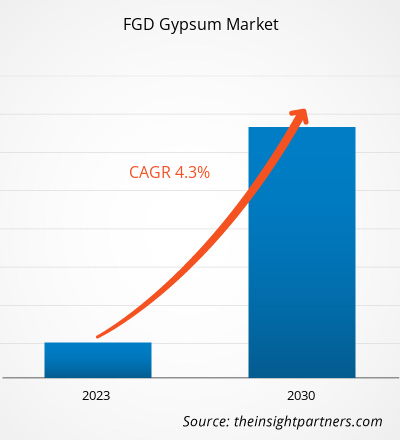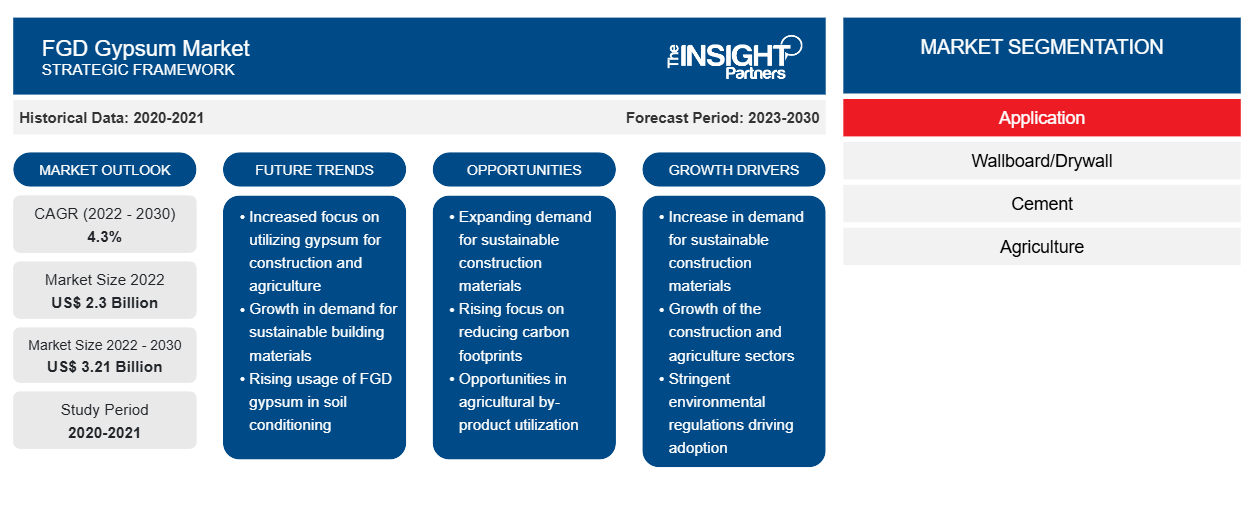[Forschungsbericht] Der Markt für FGD-Gips soll von 2.298,56 Millionen US-Dollar im Jahr 2022 auf 3.207,00 Millionen US-Dollar im Jahr 2030 wachsen; von 2022 bis 2030 wird eine durchschnittliche jährliche Wachstumsrate (CAGR) von 4,3 % erwartet.
Markteinblicke und Analystenansichten:
REA-Gips ist ein Nebenprodukt, das bei der Brenngasentschwefelung (FGD) in Kohlekraftwerken entsteht. Mit diesem Verfahren werden Schwefeldioxid-Emissionen (SO2) aus den Brenngasen entfernt, um Umweltauflagen einzuhalten. REA-Gips ist ein wertvolles Material, da er in verschiedenen Anwendungen als Ersatz für natürlichen Gips verwendet werden kann. Insbesondere der Bausektor ist ein großer Verbraucher von REA-Gips, da er bei der Herstellung von Gipskartonplatten und Zement verwendet wird. Strenge Umweltauflagen und Emissionsstandards haben Kraftwerke dazu veranlasst, REA-Systeme einzuführen, was zu einer höheren REA-Gipsproduktion führt.
Wachstumstreiber und Herausforderungen:
Gips wird in der Bauindustrie als Füllstoff für Zement und Putze verwendet, um deren Festigkeit zu erhöhen und gleichzeitig die Abbindezeit von Beton zu verkürzen. FGD-Gips, ein synthetischer Gips, wird aufgrund seiner geringeren Lebenszyklusauswirkungen im Vergleich zu natürlichem Gips stark bevorzugt. Er wird auch zur Herstellung von Dekorplatten, Trockenbauplatten, Wandbauplatten und Gipskartonplatten verwendet. Die steigende Nachfrage nach diesen Platten in der Bauindustrie stärkt die Nachfrage nach Gips. Darüber hinaus wird eine Gipsplatte, auch Trockenbauplatte genannt, gegenüber Gips bevorzugt, da sie einfacher zu installieren und zu reparieren, weniger teuer und haltbarer ist. Ihre Montage nimmt weniger Zeit in Anspruch und sie ist außerdem weithin verfügbar. Feuerbeständige Eigenschaften und praktische Verwendbarkeit sind allgemeine Faktoren, die die Verwendung von Gips im Wohnungs- und Nichtwohnungsbau erhöhen. Gipskartonplatten werden in modernen Gebäuden und Innenräumen häufig als Ersatz für Holzplatten und Betonwände verwendet, da sie einfach und schnell installiert werden können. Alternativmaterialien zu REA-Gips sind jedoch natürlicher Gips und synthetischer Gips wie Citrogips, Fluorgips, Phosphogips und Titangips. Die Kosteneffizienz von natürlichem Gips aufgrund der hohen Produktion in den größten Gips produzierenden Regionen kann sich negativ auf die Präferenz für REA-Gips für Trockenbauanwendungen auswirken. Dieser Faktor reduziert den REA-Gipsverbrauch.
Passen Sie diesen Bericht Ihren Anforderungen an
Sie erhalten kostenlos individuelle Anpassungen an jedem Bericht, einschließlich Teilen dieses Berichts oder einer Analyse auf Länderebene, eines Excel-Datenpakets sowie tolle Angebote und Rabatte für Start-ups und Universitäten.
-
Holen Sie sich die wichtigsten Markttrends aus diesem Bericht.Dieses KOSTENLOSE Beispiel umfasst eine Datenanalyse von Markttrends bis hin zu Schätzungen und Prognosen.
Berichtssegmentierung und -umfang:
Der „Globale FGD-Gipsmarkt Gypsum Market “ ist nach Anwendung segmentiert. Basierend auf der Anwendung ist der Markt in Wandplatten/Trockenbau, Zement, Landwirtschaft, Wasseraufbereitung und andere segmentiert. Der FGD-Gipsmarkt ist geografisch segmentiert in Nordamerika (USA, Kanada und Mexiko), Europa (Deutschland, Frankreich, Italien, Großbritannien, Russland und der Rest von Europa), Asien-Pazifik (Australien, China, Japan, Indien, Südkorea und der Rest von Asien-Pazifik), den Nahen Osten und Afrika (Südafrika, Saudi-Arabien, die Vereinigten Arabischen Emirate und der Rest von Nahem Osten und Afrika) und Süd- und Mittelamerika (Brasilien, Argentinien und der Rest von Süd- und Mittelamerika)FGD gypsum market, by geography, is segmented into North America (the US, Canada, and Mexico), Europe (Germany, France, Italy, the UK, Russia, and the Rest of Europe), Asia Pacific (Australia, China, Japan, India, South Korea, and the Rest of Asia Pacific), the Middle East & Africa (South Africa, Saudi Arabia, the UAE, and the Rest of Middle East & Africa), and South & Central America (Brazil, Argentina, and the Rest of South & Central America)
Segmentanalyse:
Basierend auf der Anwendung ist der REA-Gipsmarkt in Wandplatten/Trockenbau, Zement, Landwirtschaft, Wasseraufbereitung und andere unterteilt. Das Segment Wandplatten/Trockenbau hatte 2022 den größten Anteil. Wandplatten oder Trockenbau sind ein Baumaterial, das als Alternative zu herkömmlichen Ziegel-/Steinwänden verwendet wird. REA-Gips wird in der Bauindustrie häufig in Form von Wandplatten und Trockenbauwänden verwendet. Er wird als Kernbestandteil für Gips-basierte Trockenbauplatten verwendet. Der Kern der Trockenbauwand sorgt für strukturelle Festigkeit, während er gleichzeitig leicht ist. REA-Gips enthält Spuren von Calciumsulfat-Halbhydrat, das zu den feuerhemmenden Eigenschaften beiträgt. REA-Gips ist für seine gleichbleibende Qualität und Reinheit bekannt, was für die Trockenbauherstellung von Vorteil ist. Hersteller von Wandplatten und Trockenbauwänden haben die Verwendung von synthetischem Gips wie REA-Gips als wirksame Alternative zu natürlichem Gips erhöht. All diese Faktoren kurbeln den globalen REA-Gipsmarkt an.
Regionale Analyse:
Geografisch ist der Markt für REA-Gips in fünf Schlüsselregionen unterteilt: Nordamerika, Europa, Asien-Pazifik, Süd- und Mittelamerika sowie Naher Osten und Afrika. Der Asien-Pazifik-Raum dominierte den globalen Markt für REA-Gips, und der regionale Markt machte im Jahr 2022 über 1,3 Milliarden US-Dollar aus. Der Asien-Pazifik-Raum leistet einen großen Beitrag zum globalen Markt. Süd- und Mittelamerika dürften im Prognosezeitraum die höchste durchschnittliche jährliche Wachstumsrate von über 7 % verzeichnen. Der Markt für REA-Gips in Süd- und Mittelamerika ist in Brasilien, Argentinien und den Rest von Süd- und Mittelamerika unterteilt. Einer der Hauptfaktoren, die das Marktwachstum in dieser Region stützen, ist die zunehmende Bautätigkeit. Laut den USA und den brasilianischen Green Building Councils gab es in Brasilien mehr als 1,2 Millionen Quadratmeter zertifizierter Gebäude, womit es im Jahr 2021 weltweit den siebten Platz bei den Leadership in Energy and Environmental Design (LEED)-Registrierungen belegte. Laut der International Trade Administration konzentriert sich die argentinische Regierung auf Infrastrukturprojekte im Bereich von 20 Millionen US-Dollar. Daher wird erwartet, dass die Zunahme der Bautätigkeiten die Expansion des REA-Gipsmarktes in den kommenden Jahren vorantreiben wird. Auch in Nordamerika wird ein beträchtliches Wachstum erwartet, das bis 2030 über 500 Millionen US-Dollar erreichen wird.
Branchenentwicklungen und zukünftige Chancen:
Nachfolgend sind verschiedene Initiativen der wichtigsten Akteure auf dem REA-Gipsmarkt aufgeführt:
- Im Jahr 2022 investierte Georgia-Pacific LLC etwa 300 Millionen US-Dollar in die Gipskartonplattenfabrik in Sweetwater East, Texas. Das Unternehmen wollte damit seine Kapazitäten stärken, um den wachsenden Bedarf des Wohn-, Gewerbe- und Industriebausektors in Texas zu decken.
- Im Jahr 2022 brachte Adaptavate Ltd Trockenbauplatten aus landwirtschaftlichen Abfällen und einem kalkbasierten Bindemittel auf den Markt, das Kohlendioxid absorbiert. Mit diesem Ansatz konnte der Bedarf an Gips, einem emissionsintensiven Material, eliminiert werden. Das Unternehmen sammelte 2,9 Millionen US-Dollar für die Entwicklung einer Pilotlinie in Bristol, England, ein, die diese Gipskartonplatten nach Industriestandard herstellen soll.
Regionale Einblicke in den FGD-Gipsmarkt
Die regionalen Trends und Faktoren, die den FGD-Gipsmarkt im Prognosezeitraum beeinflussen, wurden von den Analysten von Insight Partners ausführlich erläutert. In diesem Abschnitt werden auch die Marktsegmente und die Geografie von FGD-Gips in Nordamerika, Europa, im asiatisch-pazifischen Raum, im Nahen Osten und Afrika sowie in Süd- und Mittelamerika erörtert.

- Erhalten Sie regionale Daten zum FGD-Gipsmarkt
Umfang des FGD-Gips-Marktberichts
| Berichtsattribut | Details |
|---|---|
| Marktgröße im Jahr 2022 | 2,3 Milliarden US-Dollar |
| Marktgröße bis 2030 | 3,21 Milliarden US-Dollar |
| Globale CAGR (2022 - 2030) | 4,3 % |
| Historische Daten | 2020-2021 |
| Prognosezeitraum | 2023–2030 |
| Abgedeckte Segmente |
Nach Anwendung
|
| Abgedeckte Regionen und Länder |
Nordamerika
|
| Marktführer und wichtige Unternehmensprofile |
|
Dichte der Akteure auf dem FGD-Gips-Markt: Auswirkungen auf die Geschäftsdynamik verstehen
Der Markt für FGD-Gips wächst rasant, angetrieben durch die steigende Nachfrage der Endverbraucher aufgrund von Faktoren wie sich entwickelnden Verbraucherpräferenzen, technologischen Fortschritten und einem größeren Bewusstsein für die Vorteile des Produkts. Mit steigender Nachfrage erweitern Unternehmen ihr Angebot, entwickeln Innovationen, um die Bedürfnisse der Verbraucher zu erfüllen, und nutzen neue Trends, was das Marktwachstum weiter ankurbelt.
Die Marktteilnehmerdichte bezieht sich auf die Verteilung von Firmen oder Unternehmen, die in einem bestimmten Markt oder einer bestimmten Branche tätig sind. Sie gibt an, wie viele Wettbewerber (Marktteilnehmer) in einem bestimmten Marktraum im Verhältnis zu seiner Größe oder seinem gesamten Marktwert präsent sind.
Die wichtigsten auf dem FGD-Gipsmarkt tätigen Unternehmen sind:
- Georgia Pacific LLC
- Cez Energetike Produkty SRO
- EP Power Minerals GmbH
- CASEA GmbH
- Holcim Ltd
Haftungsausschluss : Die oben aufgeführten Unternehmen sind nicht in einer bestimmten Reihenfolge aufgeführt.

- Überblick über die wichtigsten Akteure auf dem FGD-Gipsmarkt
Auswirkungen von COVID-19:
Die COVID-19-Pandemie wirkte sich negativ auf nahezu alle Branchen in verschiedenen Ländern aus. Lockdowns, Reisebeschränkungen und Betriebsschließungen in Nordamerika, Europa, Asien-Pazifik (APAC), Süd- und Mittelamerika (SAM) sowie dem Nahen Osten und Afrika (MEA) behinderten das Wachstum mehrerer Branchen, darunter der Chemie- und Materialindustrie. Die Schließung von Produktionseinheiten störte die globalen Lieferketten, Fertigungsaktivitäten, Lieferpläne sowie den Verkauf lebensnotwendiger und nicht lebensnotwendiger Produkte. Verschiedene Unternehmen meldeten Verzögerungen bei Produktlieferungen und einen Einbruch ihrer Produktverkäufe im Jahr 2020. Aufgrund der pandemiebedingten Wirtschaftsrezession wurden die Verbraucher bei ihren Kaufentscheidungen vorsichtiger und wählerischer. Nicht lebensnotwendige Einkäufe wurden von den Verbrauchern aufgrund niedrigerer Einkommen und unsicherer Verdienstaussichten, insbesondere in Entwicklungsregionen, erheblich reduziert. Viele Hersteller von REA-Gips meldeten Gewinneinbußen aufgrund der geringeren Verbrauchernachfrage während der Anfangsphase der Pandemie. Bis Ende 2021 waren jedoch viele Länder vollständig geimpft und die Regierungen kündigten Lockerungen bestimmter Vorschriften wie Lockdowns und Reiseverbote an. Die Menschen begannen, an verschiedene Orte zu reisen, was die Nachfrage nach REA-Gips erhöhte. All diese Faktoren wirkten sich positiv auf das Wachstum des REA-Gipsmarktes in verschiedenen Regionen aus.
Wettbewerbslandschaft und Schlüsselunternehmen:
Georgia-Pacific LLC, Cez Energeticke Produkty SRO, EP Power Minerals GmbH, CASEA GmbH, Holcim Ltd, Knauf Gips KG, Travancore Titanium Products Ltd, Compagnie de Saint-Gobain SA, American Gypsum Co LLC und National Gypsum Co gehören zu den führenden Akteuren auf dem globalen REA-Gipsmarkt. Die Akteure bieten hochwertigen REA-Gips an und beliefern zahlreiche Verbraucher auf dem globalen Markt.
- Historische Analyse (2 Jahre), Basisjahr, Prognose (7 Jahre) mit CAGR
- PEST- und SWOT-Analyse
- Marktgröße Wert/Volumen – Global, Regional, Land
- Branchen- und Wettbewerbslandschaft
- Excel-Datensatz
Aktuelle Berichte
Erfahrungsberichte
Grund zum Kauf
- Fundierte Entscheidungsfindung
- Marktdynamik verstehen
- Wettbewerbsanalyse
- Kundeneinblicke
- Marktprognosen
- Risikominimierung
- Strategische Planung
- Investitionsbegründung
- Identifizierung neuer Märkte
- Verbesserung von Marketingstrategien
- Steigerung der Betriebseffizienz
- Anpassung an regulatorische Trends























 Kostenlose Probe anfordern für - Markt für REA-Gips
Kostenlose Probe anfordern für - Markt für REA-Gips